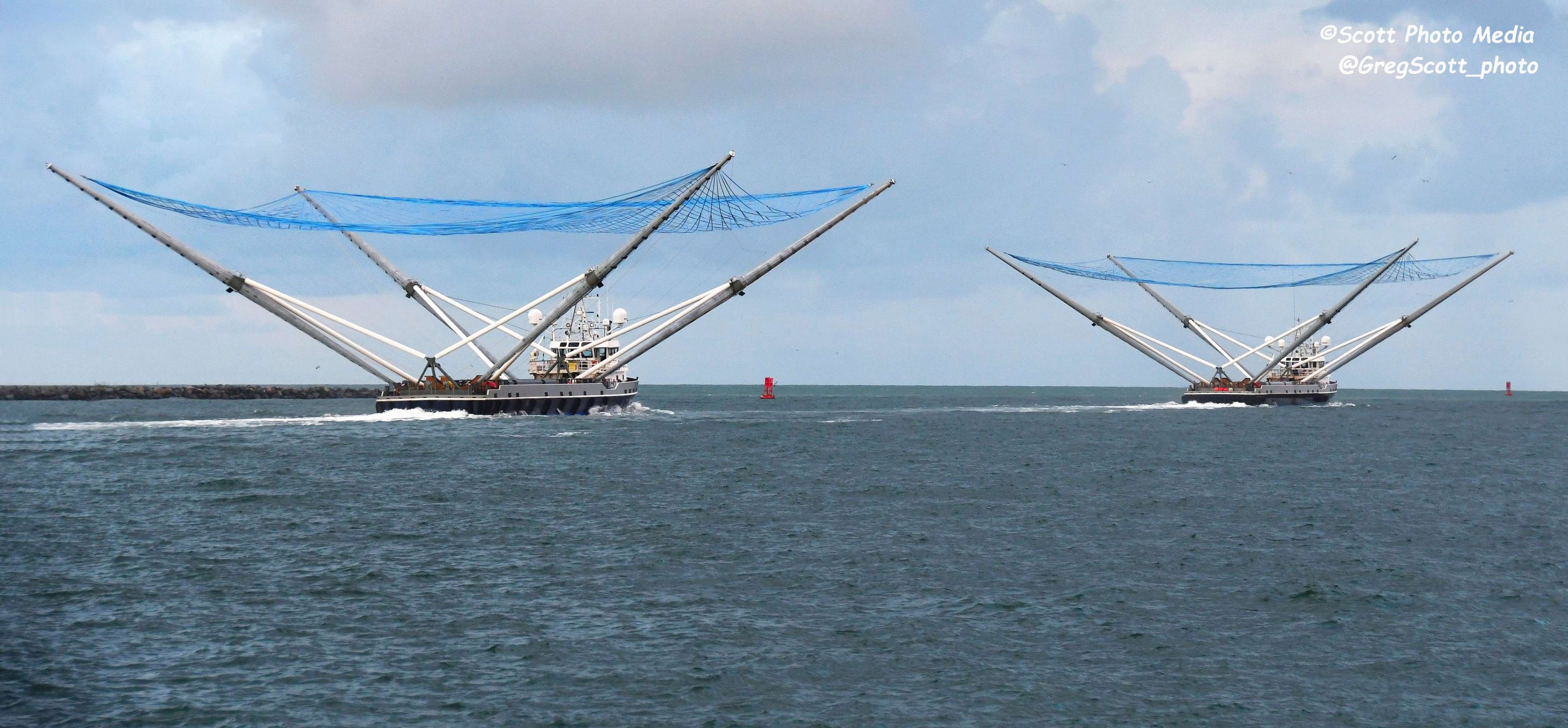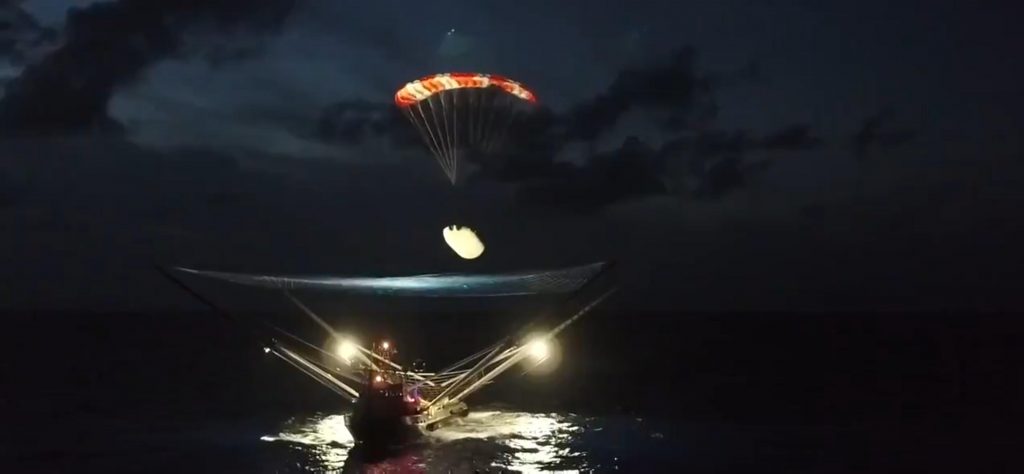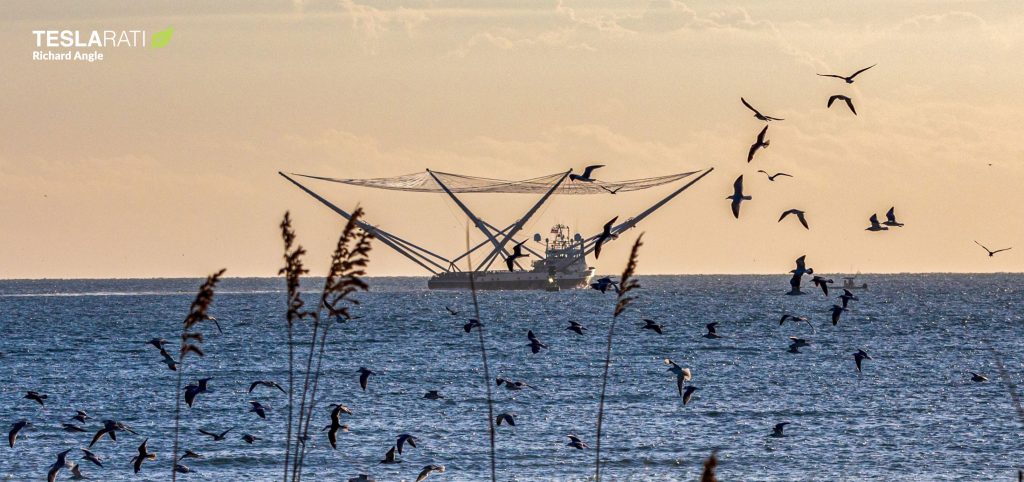

News
SpaceX recovery ships head to sea for first 'whole-fairing' catch attempt
After a brisk day-long cruise into the Atlantic Ocean, SpaceX’s twin Falcon fairing recovery ships have reached the general landing area to prepare for their first true ‘whole-fairing’ catch attempt.
Formerly known as Mr. Steven, GO Ms. Tree and new sister ship GO Ms. Chief departed Port Canaveral on December 14th and arrived at their designated recovery roughly 36 hours later. Now stationed just shy of 800 km (500 mi) downrange of SpaceX’s LC-40 Cape Canaveral Air Force Station (CCAFS) launch site, the ships are in position and can begin to prepare for Falcon 9’s Kacific-1/JCSAT-18 launch.
Scheduled to lift off no earlier than (NET) 7:10 pm ET, December 16th (00:10 UTC, Dec 17), Falcon 9 will place the ~6800 kg (15,000 lb) Kacific-1/JCSAT-18 communications satellite in a geostationary transfer orbit (GTO). Falcon 9 booster B1056 will attempt its third landing around nine minutes after launch, to be followed 25 minutes later by satellite deployment from the rocket’s upper stage. deploying the satellite around thirty minutes after launch.
If all goes according to plan, another 12-15 minutes after Falcon 9’s second stage (S2) deploys the Kacific-1/JCSAT-18 satellite, the rocket’s payload fairing halves will begin their final approach towards recovery ships Ms. Tree and Ms. Chief. Just shy of identical twins, the two ships have been outfitted with custom arms, boom supports, and nets with the intention of quite literally catching payload fairing halves out of the air after orbital Falcon 9 (and Heavy) launches.
SpaceX’s fairing recovery development program has had a long and arduous journey from Mr. Steven’s (now Ms. Tree’s) arrival at the company’s Port of Los Angeles dock space (late-2017) to the ship’s first attempted fairing catch (February 2018) and first successful catch (June 2019). In the 20+ months SpaceX has been attempting fairing recoveries, at least a dozen intentional soft ocean landings and seven net catches have been attempted, with numerous successful splashdowns and recoveries ultimately followed by two consecutive catches in June and August 2019.


The fact that SpaceX consecutively caught two fairing halves a little over two months apart after five failed catch attempts suggests that the company has effectively solved the majority of the fairing recovery challenge, becoming the first company (or space agency) in the world to do so. Unfortunately, a three-month launch lull after the second successful catch precluded any rapid-fire follow-up attempts and when that lull came to an end on November 11th, Ms. Tree and Ms. Chief were both ready but were forced to abort the attempt by rough seas.
Both ships actually spent several weeks docked (or stranded) in a North Carolina port after that aborted mission, potentially indicating that SpaceX had to fly a team north to inspect both ships’ arms and ensure that they could make the journey back to Port Canaveral. They were ultimately cleared and returned to their home port around ten days later, where their arms and booms were immediately removed. It’s unclear why that removal occurred but SpaceX’s recovery team rapidly reinstalled their arms in just a few days, followed by their nets soon after.
Given that their first simultaneous (i.e. ‘whole-fairing’) catch attempt was aborted before it could start, it’s safe to say that December 16th’s hopeful attempt will be Ms. Tree’s and Ms. Chief’s first side-by-side recovery mission. Both ships have successfully reached the recovery zone, a step further than they managed to get on their November attempt. Coincidentally, that November launch happened to mark both SpaceX’s and the world’s first launch of a flight-proven payload fairing, both halves of which were recovered from the ocean and represented a more or less worst-case scenario for reuse.
And nevertheless, that reuse was a flawless success, marred only by the fact that Ms. Tree and Ms. Chief were unable to attempt to recover the world’s first twice-flown payload fairing. In short, all the conditions are right for what could be the world’s first successful recovery of both halves of an orbital-class payload fairing. If successful, SpaceX will have effectively closed the book on Falcon 9 and Heavy reusability development, having proven that both boosters and fairings can be reliably and routinely recovered and reused.
Check out Teslarati’s Marketplace! We offer Tesla accessories, including for the Tesla Cybertruck and Tesla Model 3.
News
SpaceX’s Crew-11 mission targets July 31 launch amid tight ISS schedule
The flight will lift off from Launch Complex 39A at Kennedy Space Center in Florida.

NASA and SpaceX are targeting July 31 for the launch of Crew-11, the next crewed mission to the International Space Station (ISS). The flight will lift off from Launch Complex 39A at Kennedy Space Center in Florida, using the Crew Dragon Endeavour and a Falcon 9 booster.
Crew Dragon Endeavour returns
Crew-11 will be the sixth flight for Endeavour, making it SpaceX’s most experienced crew vehicle to date. According to SpaceX’s director of Dragon mission management, Sarah Walker, Endeavour has already carried 18 astronauts representing eight countries since its first mission with NASA’s Bob Behnken and Doug Hurley in 2020, as noted in an MSN report.
“This Dragon spacecraft has successfully flown 18 crew members representing eight countries to space already, starting with (NASA astronauts) Bob (Behnken) and Doug (Hurley) in 2020, when it returned human spaceflight capabilities to the United States for the first time since the shuttle retired in July of 2011,” Walker said.
For this mission, Endeavour will debut SpaceX’s upgraded drogue 3.1 parachutes, designed to further enhance reentry safety. The parachutes are part of SpaceX’s ongoing improvements to its human-rated spacecraft, and Crew-11 will serve as their first operational test.
The Falcon 9 booster supporting this launch is core B1094, which has launched in two previous Starlink missions, as well as the private Ax-4 mission on June 25, as noted in a Space.com report.
The four-members of Crew-11 are NASA astronauts Zena Cardman and Mike Fincke, as well as Japan’s Kimiya Yui and Russia’s Oleg Platonov.
Tight launch timing
Crew-11 is slated to arrive at the ISS just as NASA coordinates a sequence of missions, including the departure of Crew-10 and the arrival of SpaceX’s CRS-33 mission. NASA’s Bill Spetch emphasized the need for careful planning amid limited launch resources, noting the importance of maintaining station altitude and resupply cadence.
“Providing multiple methods for us to maintain the station altitude is critically important as we continue to operate and get the most use out of our limited launch resources that we do have. We’re really looking forward to demonstrating that capability with (CRS-33) showing up after we get through the Crew-11 and Crew-10 handover,” Spetch stated.
Lifestyle
EV fans urge Tesla to acquire Unplugged Performance for edge in fleet and security industry
Unplugged Performance has built a name for itself by producing performance upgrades for Tesla vehicles.

A growing number of Tesla enthusiasts and longtime community voices are calling on the electric vehicle maker to acquire Unplugged Performance, a California-based aftermarket company best known for tuning Tesla vehicles and developing specialized government fleet solutions under its UP.FIT division.
The idea was once considered a niche proposal among EV fans, but it is now gaining serious attention not just as a performance play but as a strategic move to deepen Tesla’s roots in the fleet and security industry.
A strategic fit
Unplugged Performance has built a name for itself by producing performance upgrades for Tesla vehicles, from track-optimized components to visual and aerodynamic upgrades. But in recent years, its UP.FIT division has pivoted toward a more functional future by outfitting Tesla vehicles like Model Ys for police, military, and government use.
That work has sparked growing calls for closer collaboration with Tesla, especially as the EV maker increasingly leans into autonomy, AI, and fleet services as core components of its next chapter.
“I posted this four years ago, but I think it’s more true now than ever,” wrote Whole Mars Catalog, a well-known Tesla investor and FSD Beta tester, on X. “Tesla should buy Unplugged. But not just as a Performance division. What they are doing with UP.FIT unlocks large government and commercial fleet purchases that can improve utilization.”
Tesla fans such as shareholder Sawyer Merritt echoed the sentiment, calling Unplugged a “great fit within Tesla.” adding, “They are literally located directly next to Tesla’s design studio in Hawthorne.”
Enabling the next wave
Supporters of the idea noted that integrating Unplugged into Tesla’s corporate structure could help accelerate the adoption of autonomous technologies in government sectors. With UP.FIT patrol cars already in use across some U.S. police departments, Tesla fans envisioned a future where self-driving Teslas could potentially revolutionize law enforcement, search-and-rescue, and public service logistics.
“Just imagine how autonomous patrol cars could transform policing and bring us into a safer future,” the veteran FSD tester wrote.
The benefits could also extend to Tesla’s existing consumer base. “They also have some incredible products in the works that I think will appeal to many ordinary Tesla drivers — not just those looking for performance or mods. Stuff that’s so good it should have come straight from the design studio next door,” Whole Mars Catalog noted.
Unplugged Performance, founded in 2013, shares not just a product vision with Tesla, but also geography. Its Hawthorne headquarters sits directly adjacent to Tesla’s design studio, and the two companies have maintained a close working relationship over the years. The aftermarket firm has long positioned itself as a “mission-aligned” partner to Tesla.
In response to the recent calls for acquisition, Unplugged Performance acknowledged the support from the community. “Our very existence is to support the Tesla mission with @UpfitTesla and @UnpluggedTesla,” Unplugged CEO Ben Schaffer posted on X. “We love working with Tesla and are grateful for the community’s support since 2013!”
News
Tesla debuts hands-free Grok AI with update 2025.26: What you need to know
All new Tesla vehicles delivered on or after July 12, 2025, will include Grok AI out of the box

Tesla has begun rolling out Grok, an in-car conversational AI assistant developed by xAI, to eligible vehicles starting July 12. The feature marks the most direct integration yet between Elon Musk’s artificial intelligence startup and Tesla’s consumer product lineup, offering drivers hands-free access to a chat-style companion while on the road.
Grok comes pre-installed on new vehicles
According to Tesla’s FAQ page for the feature, all new vehicles delivered on or after July 12, 2025, will include Grok AI out of the box. Owners of older vehicles may gain access through an over-the-air update, provided their vehicle meets a few hardware and software requirements.
Specifically, Grok is currently only supported on Tesla models equipped with an AMD infotainment processor and running vehicle software version 2025.26 and higher. Compatible models include the Model S, Model 3, Model X, Model Y, and Cybertruck. A Premium Connectivity subscription or active Wi-Fi connection is also required.
Tesla notes that additional vehicle compatibility may arrive in future software updates.
Grok’s features and limitations for now
Drivers can engage with Grok using the App Launcher or by pressing and holding the voice command button on the steering wheel. Grok is designed to answer questions and hold conversations using natural language, offering responses tailored to its chosen personality—ranging from “Storyteller” to the more eccentric “Unhinged.”
For fun, Tesla posted a demonstration of Grok likely running on “Unhinged” talking about what it would do to Optimus when they are on a date, much to the shock of the humanoid robot’s official social media account.
It should be noted, however, that Grok cannot currently issue commands to the vehicle itself, at least for now. Traditional voice commands for tasks like climate control, navigation, or media remain separate from Grok as of writing.
The feature is being released in Beta and does not require a Grok account or xAI subscription to activate, although that policy may change over time.
Grok privacy and in-car experience
Tesla emphasizes that interactions with Grok are securely processed by xAI and not linked to a user’s Tesla account or vehicle. Conversations remain anonymous unless a user signs into Grok separately to sync their history across devices.
Tesla has also begun promoting Grok directly on its official vehicle webpages, showcasing the feature as part of its in-car experience, further highlighting the company’s increasing focus on AI and infotainment features on its all-electric vehicles.
-

 Elon Musk2 weeks ago
Elon Musk2 weeks agoTesla investors will be shocked by Jim Cramer’s latest assessment
-

 Elon Musk3 days ago
Elon Musk3 days agoxAI launches Grok 4 with new $300/month SuperGrok Heavy subscription
-

 Elon Musk5 days ago
Elon Musk5 days agoElon Musk confirms Grok 4 launch on July 9 with livestream event
-

 News1 week ago
News1 week agoTesla Model 3 ranks as the safest new car in Europe for 2025, per Euro NCAP tests
-

 Elon Musk1 week ago
Elon Musk1 week agoxAI’s Memphis data center receives air permit despite community criticism
-

 News2 weeks ago
News2 weeks agoXiaomi CEO congratulates Tesla on first FSD delivery: “We have to continue learning!”
-

 News2 weeks ago
News2 weeks agoTesla sees explosive sales growth in UK, Spain, and Netherlands in June
-

 Elon Musk2 weeks ago
Elon Musk2 weeks agoTesla scrambles after Musk sidekick exit, CEO takes over sales
















